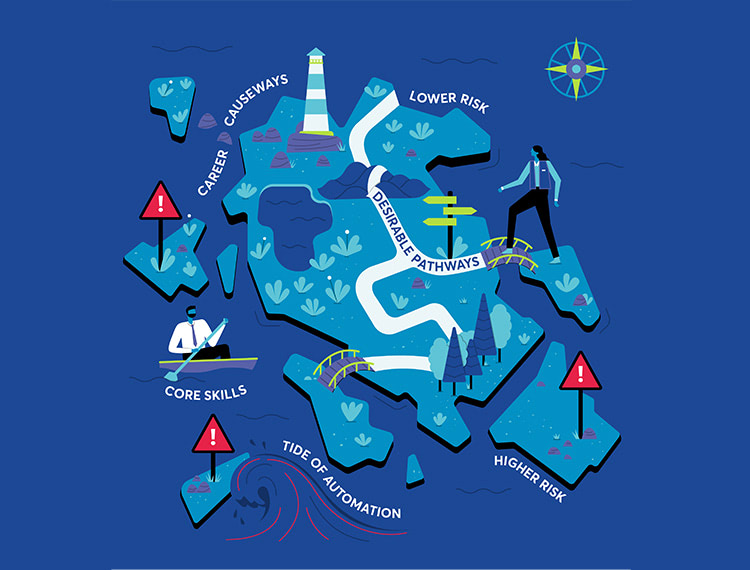Machine learning used for smart job market map to support people into work in uncertain times

@nesta_uk and @jpmorgan report: Mapping Career Causeways: Supporting workers at risk is released today exploring Machine learning used for smart job market map to support people into work in uncertain times
As the job market reels from the shock of COVID-19 and unemployment rises sharply, pioneering data science methods have been used to identify viable career transitions for people based on their current skillset. Mapping Career Causeways: Supporting workers at risk is published today by Nesta, the innovation foundation, and supported by J.P.Morgan. The study shows how data analysis can be used to identify jobs that use a similar skillset, but have a lower risk of automation. A map has been published alongside the study to demonstrate how this would work in practice.
The study, which analysed over 1,600 different occupations, found that:
-Retail and customer service roles and administrative and business clerks are at greatest risk of automation
-Risk of automation is higher when jobs have predictable environments and involve routine interaction
-Workers in jobs that are at high risk of automation may find it harder to escape automation risk, as jobs that require similar skills tend to face similar levels of automation risk.
The report also revealed that in the UK:
-The highest proportion of at-risk workers are in the North West (17per cent) and the lowest are in the East Midlands (14.5 per cent)
-21 per cent of female workers are in at-risk occupations, compared to just 12 per cent of male workers
-Workers whose incomes are among the lowest 20 per cent face a risk of automation that is around three times higher than that faced by workers whose incomes are among the highest 20 per cent.
As economies look to recover from COVID-19 and its cataclysmic impact on many industries, understanding automation risk is more important than ever. COVID-19 has caused high levels of unemployment in itself, but it is also likely to speed up the impact of automation through the increased uptake of technology to reduce face to face interaction, and by reducing the career options available in fields such as food and leisure. Millions of workers across Europe will need to retrain for new roles, and focusing on occupations at lower risk of automation will be a better investment for people and economies more widely.
The study finds that once you’re in a job that has a high risk of automation it can be hard to escape, as other jobs that require similar skills tend to face similar levels of automation risk. One third of similar or better paid roles that could be a viable switch for an ‘at risk’ worker will take them straight back into roles that are at high risk of automation. Nesta’s approach to navigating the labour market system uses information about skills and careers so that workers can be supported to transition between jobs with greater confidence.
Careers advisers, jobcentres, policymakers, employers and individuals can use the insights in this report to suggest retraining in specific skills so that workers can broaden their options. This could involve training in a special set of core skills that can broaden the options for a range of at-risk workers. The report identifies that many of these fall into four key areas: management skills, communication skills, information analysis and evaluation skills and compliance-related competencies. The other option would be to tailor upskilling for each individual based on their current role. This can be done by identifying a desirable role and training them in the specific skills to reach that role.
Jyldyz Djumalieva, Head of the Open Jobs Data team at Nesta says, “The Mapping Career Causeways approach has the potential to broaden and enrich the careers advice available to workers and job seekers. In the example map we have overlaid data on automation, but the map itself can be used to consider the impact of any labour market shock, including COVID-19.
“When faced with changing sectors, most people don’t know where to start. Data driven approaches can help job seekers find new possibilities. Perhaps more importantly, we think that careers advisers, jobcentres and policymakers could use these findings to tailor upskilling and reskilling programmes based on the skill needs of individual workers.”
Hang Ho, Head of Global Philanthropy EMEA and LATAM, J.P. Morgan says, “The COVID-19 pandemic has accelerated trends, like automation, that are re-shaping the way we work. At JPMorgan Chase, we are committed to helping prepare our own workers and people in underserved communities for the future of work. Connecting workers with the skills that they need for stable and well-paying jobs is critical to social mobility.”
Over the next year, Nesta will trial use cases for the map, and is seeking partners, from employment services, careers advisors and education institutions to local governments, policy makers and employers to work with on this. This work will involve validating the transition pathways, testing different methods for delivering insights from the map and extending the map by, for example, incorporating the availability of jobs in a worker’s local area.
Participants in Nesta’s Rapid Recovery Challenge (set up in partnership with J.P.Morgan and Money and Pension Service) may test the map to deliver job recovery solutions which will rapidly scale between December 2020 and September 2023. The Challenge was launched in September to support tools and services that improve access to jobs and money for people across the UK, focussing on those hardest hit by the economic shock resulting from COVID-19. Fourteen semi-finalists will be announced on 9th December. These semi-finalists will each receive £125k and capacity-building support to develop and scale their solutions.
*Main article image ‘Design by Kirstin Smith’












Responses